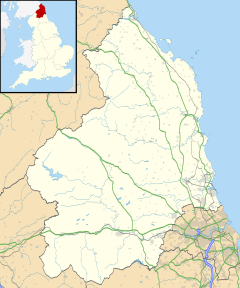Wylam Railway Bridge
| Wylam Railway Bridge | |
|---|---|

Wylam Railway Bridge as seen from the south bank of the River Tyne
|
|
| Coordinates | 54°58′23″N 1°49′41″W / 54.973°N 1.828°WCoordinates: 54°58′23″N 1°49′41″W / 54.973°N 1.828°W |
| OS grid reference | |
| Carries |
Footpath Cycleway formerly Railway |
| Crosses | River Tyne |
| Locale | Northumberland, England |
| Characteristics | |
| Design | Wrought iron Through arch bridge. |
| Total length | 80 m (260 ft) |
| History | |
| Construction start | 1874 |
| Construction end | 1876 |
| Opened | 6 October 1876 |
Wylam Railway Bridge, also known locally as Points Bridge, Half-moon Bridge, Hagg Bank Bridge, Bird Cage Bridge, or The Tin Bridge, is a footbridge and former railway bridge crossing the River Tyne at Hagg Bank, approximately 0.5 miles (0.80 km) west of Wylam in Northumberland, England.
The bridge was originally built for the Scotswood, Newburn and Wylam Railway, to connect the North Wylam Loop with the Newcastle and Carlisle Railway.
A number of bodies were involved in the bridge's construction: W G Laws engineered the bridge, W E Jackson & Co. of Newcastle upon Tyne built the bridge's foundations and masonry, while Hawks, Crayshay & Co. of Gateshead manufactured the ironwork. The bridge cost £16,000 to build and was opened to rail traffic on 6 October 1876.
Railway services over the bridge ended in 1968 when the line was closed, as one of the Beeching cuts. The trackwork was removed in 1972 and subsequently, in 1975, the bridge was converted into a footbridge and cyclepath linking Wylam with the Tyne Riverside Country Park at Low Prudhoe.
The bridge's design came about because there was a need to avoid having piers in the river bed, because their construction would have disrupted shallow mine workings underneath. It has been suggested that Wylam Railway Bridge might have been an inspiration for the designers of the much later Tyne Bridge in nearby Newcastle and the Sydney Harbour Bridge in Australia.
Wylam Railway Bridge is one of the earliest through arch bridges in the world.
...
Wikipedia

